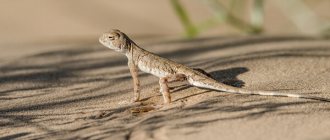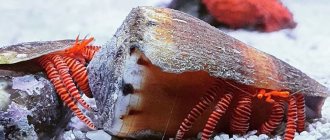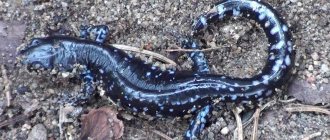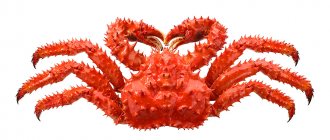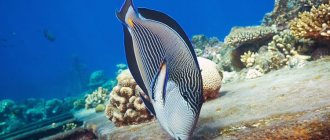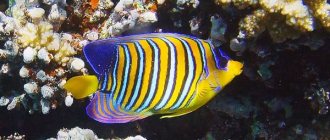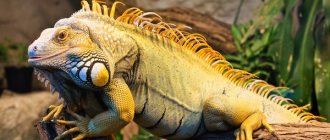In this article we will look at whether the copperhead is dangerous and its differences from other snakes.
Reptiles, especially snakes, that live near human habitation have always caused fear. And the copperhead has gathered around itself many dangerous stories and legends since ancient times. Moreover, the red-eyed snake or legless lizard was associated with evil spirits. This article will provide material on who such a reptile actually is. Should you be afraid of her and how to protect yourself from her attack if circumstances require it.
Common copperhead - snake or legless lizard: brief description
The common copperhead has a “sister” by name. In nature, there is another reptile with a similar root “name” - the copperhead or brittle spindle. Therefore, it is worthwhile to immediately understand this issue in order to dispel all the myths and rumors about such animals.
IMPORTANT: The copperhead is a snake! It belongs to the class Reptiles and the family Colubridae, and its species is non-venomous Snakes. But the copperhead is already a pseudo-legged lizard , which belongs to a completely different class - Reptiles, from the spindle family. Therefore, do not confuse these two different animals! And one should not call a snake and a lizard by the same name.
- The common copperhead is a small snake that is often mistaken for a viper. But they note its great strength and strength. The maximum length of the copperhead is 60-70 cm. Moreover, the body covers 4-6 times more length than the tail. More precisely, the copperhead is distinguished by its short tail.
- It is compared to a viper because the copperhead has smooth, dark-colored dorsal scales in the form of diamonds or hexagons. Which is very similar to the “zigzag” of a viper.
- Their color is also often almost identical. But there is a main difference between the copperhead and all other species, and for which it received its “name” - it is a copper tint. A special place is the belly and around the head. It is in this area that any color of the snake will shimmer with the color of copper.
- The color of the copperhead can be from a paradoxical gray color to a brown-brown-red color. Moreover, they can have a light tone of gray or such a rich shade that it looks like a black color.
- A distinctive feature of copperheads is that the female is always darker than the male. There is also a pattern when the snake becomes several tones darker during the molting period.
Snake
- Their abdomen can also be of different colors - from gray to red-brown, which often happens with a copper tint. But there are even representatives with a steel-colored belly.
- Copperheads can be completely monochromatic. Sometimes there are snakes with brown or black spots all over their bodies. There may be blurry spots or clear lines in the middle.
IMPORTANT: The iris of the copperhead’s eyes is yellow or red! It all depends on the species and habitat, but there are no other colors.
- Another small recommendation on how to determine the sex and age of a copperhead - look at the color intensity. If there are more red notes in its color, then this is a male, but a female has calmer brown tones.
- With age, the brightness of the color and clarity of the pattern is washed off and lost. Therefore, if you see a copperhead with a bright color, then it is young.
Types of spindles
- Anguis cephallonica or Peloponnesian worm of the Cephalon spindle class, natural habitat - temperate climate.
- Anguis colchica - until recently was considered a subspecies of spindles. Today, it is positioned as a separate class of reptiles.
- Anguis fragilis is the same brittle spindle . The main features of the species are its incredibly wide range and life expectancy of up to 35 years.
- Anguis graeca is the rarest species. Habitat: continental and Mediterranean climate zone.
- Anguis incomptus is the rarest species, found in just one Mexican state. Strictly protected and carefully studied.
- Anguis veronensis is an Italian worm. It is distinguished by the presence of microscopic legs and habitat, in accordance with the name of the subspecies.
The spindle class itself has 13 genera, including 120 subspecies. Both serpentine and five-toed lizards with 4 limbs can be found. As mentioned earlier, all these species have one characteristic feature - the outer cover, which unites them into a single class.
The spindle is a legless lizard
Common copperhead - poisonous or not?
We made a slight reservation on a similar topic when we recalled the appearance of the copperhead. But this question has a certain catch - it is a poisonous snake, but not for humans.
- The fact is that she has poisonous teeth. But they are located in the very depths of the mouth, especially since the size of the copperhead’s mouth is very small. Therefore, it will not harm a person. But, swallowing prey, it can easily kill it.
- It is also worth noting that it uses the secretions of the paracloacal glands to attack. They have an extremely unpleasant odor.
- To defend or attack, it often uses toxic saliva to paralyze. After all, its size is not so large as to strangle its victim. Therefore, before a meal, she paralyzes her.
Dangerous snake, but not for humans
- But we must not forget that she produces this toxin and the poison itself in small quantities. Therefore, the copperhead does not harm a large animal or, especially, a person.
- All rumors about its poisonousness are rooted in its resemblance to a viper.
- Also, people have long been frightened by her red eyes. There is even such a version: if bitten by a “copper snake,” the person will die before sunset.
- Many people attack the copperhead, mistaking it for a viper.
IMPORTANT: The copperhead is protected by law, since mass extermination has led to a decrease in the genus. This is a rare species! In some countries it is listed in the Red Book.
Differences from snakes
When people encounter a legless lizard, they most often mistake it for a poisonous snake and try to kill the animal. Of course, reptiles have similarities: both legless lizards and snakes move by wriggling their bodies. However, if you look closely, you can find several pronounced differences between the two types of reptiles. Let's look at the difference using the example of two lizards: the spindle and the yellow-bellied lizard.
Firstly, they have movable eyelids, while in snakes they are fused, thereby forming a transparent protective layer over the eyes. Lizards have an ear opening, which is located behind the organs of vision. Snakes do not have it.
Secondly, the head and body are fastened differently in reptiles. If the spindle and the yellow-bellied do not have any narrowings in the neck area, then in snakes they are clearly pronounced.
What is the difference between a legless lizard and a snake? In lizards, the left and right parts of the jaws are connected more rigidly, in addition, these animals have a shoulder girdle.
TYPES OF SNAKES: CHARACTERISTICS AND STRUCTURE, LIFESTYLE
GYURZA SNAKE: TYPES, DESCRIPTION, PHOTO, NUTRITION, POISON, REPRODUCE, FEATURES
CAUCASIAN VIPER: DESCRIPTION AND PHOTO
CURRENT GECKO KEEPING AT HOME, PHOTO
How to distinguish a copperhead from a viper?
- Eyes are an important difference between these families. The viper has a vertical pupil, while the copperhead has a round pupil!
- Look at the shape of the viper's tail - it is short, thick and blunt. Colubrid reptiles have a narrower, relatively long and sharp tail. The tip of the viper itself is painted in a different color - yellow, orange or red.
- The viper's head is separated from the body and has a triangular shape, somewhat reminiscent of a spear. In the copperhead it acts as an extension of the body.
- While the color can be confusing, the scales are not. In a viper, each scale has a certain elevation in the center, which seems to divide it in half. That is, there is a cue . The copperhead doesn't have this!
- The viper also has a zigzag dark stripe , but it is not present in all species. Therefore, this is not the most reliable way to differentiate.
The main difference is the teeth
- The viper has poisonous front teeth . The copperhead does not have them. Her front teeth are not so developed, so they are not conspicuous.
IMPORTANT: Do not even think about touching a dead snake. Especially if there are signs of a viper lying there. Under no circumstances should her teeth be checked. This is not the most important sign to recognize the viper and copperhead. The danger lies in the fact that even a dead poisonous snake has venom on its teeth!
Yellow Tummy
The legless yellow-bellied lizard also has another name - capercaillie. This reptile is large, its length is one and a half meters. The yellow-bellied lizard is not quite a legless lizard. The remains of the limbs are represented by two claws located along the edges of the cloaca. They are most pronounced in adult males. The reptiles belong to the genus Armored spindles.
The appearance of lizards is as follows: they have a long body, protected by fused scales. They perform the function of a shell. Skin folds run along the sides of the body. There are two of them in total. They simplify the life of lizards, facilitate their breathing and provide elasticity to the shell when eating large pieces of food. The color of the body can be brown and yellowish, often red blotches appear on it. It is easy to determine the age of a lizard by the color of its shell: individuals that are not yet a year old have a striped coloration, represented by dark stripes against a brown-yellow background.
Copper snake - varieties: brief description, photo for children
Varieties of copperhead have not been fully studied. New subspecies are constantly being discovered. But science classifies them all as one species – the common copperhead. They are divided mainly by different colors.
Ordinary
Brown
In Russia, the gray or brown copperhead is more common. There are red or even pinkish copperheads. And in some areas there is even a black copperhead. But their most important feature is the copper tint of the back and abdomen.
How we fought snakes
We moved into our house in Kuban in the second half of November, when all the reptiles were already fast asleep in secluded places. All winter, the locals frightened us with stories about the snakes that live here (without names) and, like fishermen, they demonstrated their dimensions with their arms spread wide. Apparently, no one was ever harmed by snakes, but the stories were scary - where would Stephen King be?
Therefore, the first small viper we discovered sleeping under a pile of bark near the woodshed was mercilessly destroyed. It's still a shame. The all-knowing Internet clarified the peculiarities of the life of snakes, and we decided to shoo them away from the site in an amicable way.
At the beginning of spring, the perimeter of the woodshed was generously covered with dry mustard. We cut out the blackberry thickets around the perimeter of the site (snakes love secluded corners). Heaps of stones were cleared away. A friend from a nearby street complained that vipers had to be constantly chased out of an artificial pond with nymphs. The decorative pond was removed from our plans until the situation was clarified.
The mating period, and therefore the maximum activity of snakes, occurs here in April. For us, this coincided with the beginning of mowing, the grass had already grown enough. During mowing, the first to emerge was a healthy grass snake, about a meter long. Black, with a yellow bow at the back of the head. The trimmer is electric, and he was very scared. They stopped the mowing, gave me time to come to my senses, and then kicked me out of the area with a stick.
In a low and damp place, a small, 15 centimeters, yellow-bellied snake came under the trimmer line. Not far away, a water snake barely managed to escape (I had prepared myself over the winter by carefully studying the external signs of the snakes living here). Then they continued to mow more carefully in order to scare away rather than injure the snakes. Several times different tails flashed in the grass.
Since in the first year of living in a new place we actually had no neighbors, and there were thickets on all sides, we decided to treat the perimeter with Roundup and then burn the remains. Local snakes do not crawl on bare ground. During the first summer, when the grass was mowed regularly, no more snakes were found.
In subsequent years, when bees were brought in and mowing became less frequent, so that the bees could collect everything they needed, snakes and snakes began to appear again. Rarely, closer to the forest and an abandoned neighboring site. We don’t actively fight them, we just chase them with the dog.
Water snake (Natrix tesellata). GHRA Rhône Common viper (Vipera berus). Greg Cottonmouth (Gloydius halys). Greg
Where does the copperhead live in Belarus, Russia, the Urals, Crimea, Tatarstan, how long does it live?
Such a snake lives about 10-15 years. Everything depends on living conditions. In captivity, they can live much longer, because the threat of attack by natural enemies disappears. They often become prey for wild boars, rats or martens, as well as some birds and hedgehogs. Juveniles may be attacked by grass frogs.
- The copperhead loves warmth, which is why it looks for sunny places. She can swim, but avoids swampy and damp places, as well as those near water bodies.
- It can be found in almost all deciduous forests. The secret is that she hides behind the leaves, but in meadows or steppes she can stumble upon her enemy. Therefore, the copperhead avoids them. You can also find the copperhead in the coniferous forest.
- This snake lives in both Belarus and Tatarstan, and also covers all European countries. In Russia, it reaches the border of Siberia and Lake Onega. In general, she chooses the southern side of European regions.
The copperhead loves warmth
- If we talk about the subalpine zone, the copperhead can rise 3000 meters above sea level.
- Their peak activity occurs in the morning and evening. Rarely occurs at night, but such cases have been reported.
- These snakes can attack their relatives. Therefore, only one snake coexists in one territory. Copperheads lead a solitary lifestyle. Such a “plot” of one snake does not exceed more than 1 hectare.
Protection from enemies
These animals are protected by a hidden lifestyle, as well as by bone chain mail located under the scales. In addition, they can throw off their tail and also “shoot” excrement. Unusual defensive behavior is observed in young individuals. In case of danger, young copperheads roll over onto their backs, showing their dark belly. Apparently, such a change in color produces the effect of surprise.
However, this arsenal is not enough, so the spindle often becomes a victim of various predators. Both ground beetles (predatory beetles), and various snakes, and toads eat young lizards. Martens, foxes, hedgehogs, badgers, night and day birds (there are more than 25 species of birds that feed on copperheads) - this is not a complete list of enemies of the species of interest to us. It is curious that among the snakes, the copperhead is especially often swallowed by the copperhead. People also destroy these lizards very often. In different countries there is a strange superstition about their “terrible poisonousness,” although in fact the spindles are absolutely harmless.
What does a copperhead eat in nature: a description for children
It is worth noting that copperheads are very slow, so they attack resting prey or use ambushes. For these purposes, they are armed with grass or foliage.
- The basis of their diet is lizards. Often a battle can even break out between them. By the way, a copperhead can defeat a representative larger than its size. If the lizard grabs onto the snake very tenaciously, then the copperhead can tear it off along with its skin.
- They love lizards of all kinds - this is 60% of their diet. But more often they feast on spindles and nimble lizards.
- The copperhead has very well developed muscles. Stronger than that of a viper or snake. Therefore, she wraps the victim in several rings that can tenaciously hold even, for example, a small paw.
Copperheads feed on lizards
- The diet is also supplemented by rodents, especially voles and mice. Its menu also includes shrews, sparrows and some types of other snakes. She mainly chooses the cubs. This diet covers approximately 5% of the entire meal.
- The rest falls to the lot of insects and frogs (baby snakes especially feast on them).
- By the way, cases of cannibalism were also noted among copperheads. And the copperhead can often attack an entire nest of some animal and destroy all the offspring.
Delicious dishes
First, let's figure out what serves as food for this reptile. It eats insects, invertebrate mollusks, and small vertebrates. If he manages to get it, he does not disdain bird eggs. In times of hunger, it eats fruits. Interestingly, when meeting with a viper, the yellow-bellied one will win. Its body is covered with hard scales, which prevents the snake from biting and injecting poison. And the jaws are so powerful that they allow the lizard to easily bite a viper in half. After this, the snake will be eaten. The yellow belly eats by biting off its prey one piece at a time, rather than swallowing it whole. Therefore, this process is long. The yellowtail can bite off the tail of its relatives, which it also eats.
How the respiratory system of the copperhead works: description
Despite this peculiar shape, the copperhead and other snakes have internal organs. But there is a certain feature that is common to the entire class.
- In the copperhead and other species, the left lung is reduced. This is due to the fact that the shape of the snake is narrow and oblong, and it has to crawl on the ground. To be able to wriggle without squeezing the organs, nature reduced one lung by almost 85%. It practically does not play any important role.
- But the right lung stretched to about a third of the length of the entire body. All responsibility for breathing rests with him.
- They also have a tracheal lung. It has a bag-like shape and is a continuation of the trachea. Its location is on the upper side of the posterior trachea. The tissue composition is reminiscent of a sponge, since it has many small cells in which gas exchange occurs.
IMPORTANT: The tracheal lung of snakes is used in situations, for example, when the right lung is compressed by a swallowed large animal. That is, its use is compensatory.
- Copperheads and other snakes have another unique feature - they can breathe while eating. They swallow their prey. Therefore, in order not to block the access of oxygen, this trachea is moved slightly to the side. And it allows you to breathe while eating.
- Just like other serpentine species, copperheads have an organ of charm that is their tongue. It is with its help that they catch odors.
The spindle is brittle. Legless lizard with the appearance of a snake
A small snake-like lizard was first described by Carl Linnaeus. The self-explanatory name of the spindle suggests that the shape of the body resembles a spindle, and the property of throwing off the tail added the characteristic of being brittle. Among reptiles inhabiting terrariums, it has been found more often than others since ancient times for its beautiful appearance and docile nature.
How dangerous is the copperhead snake for humans?
In principle, the copperhead does not pose a serious danger to humans. It has already been mentioned that its poisonous teeth are located deep in its mouth. Therefore, for her to bite you, you will need to stick your finger deep into the throat. Similar cases have not yet been observed.
- But, like any reptile or even just a wild animal, it can cause infection. Especially if there was a bite to the point of bleeding. This happens, although relatively rarely. In situations where the place of attack was the hand or fingers.
- Do not forget that the copperhead does not clean its teeth, and can also feed on poisonous relatives. An infection from another animal or simply a piece of food that has already decomposed may remain on the teeth. In general, there is no talk of sterility. Therefore, the wound must be treated without fail.
- Persons with weak immune systems will be affected. After all, any infection can develop into a serious illness.
The snake does not pose a serious danger
- Allergy sufferers are also at risk! The reaction may not be limited to just a rash, itching or redness. Don't forget that allergies can affect the respiratory system. And the person will simply suffocate because the swollen throat will cut off oxygen.
- Small children can be bitten more easily and forcefully. And their curiosity often becomes the reason for this. Plus, young children do not have strong immunity to resist most dangerous diseases.
- Elderly people can also suffer from a copperhead bite. Any reptile attack affects heart function and blood pressure levels. Elderly people often experience differences in this area.
- The condition may worsen, as with any bite from a wild animal. The bite site will hurt and cause discomfort. But, if there are no allergies, infections and complications, then there is no danger.
Nutrition
Due to the specific nature of hunting, lizards choose damp, dark places to live. Their main diet is the same, leisurely underground inhabitants - earthworms, slugs, caterpillars, etc. The lizard's olfactory organ is the tongue. Like this? Not easy enough.
Spindles suck in air through their noses, however, they use their tongues for detailed chemical analysis. This species has the finest sensitive “hairs” on the palate. By sticking out its tongue, the reptile, as it were, takes a sample and analyzes the composition of the sample.
The same thing happens with food. Having discovered and caught the prey, the lizard carefully examines it and only after that the swallowing process begins. You can also notice how she constantly rubs her head while “eating.” This is to remove any remaining food or mucus.
The lizard's main assistants in hunting and eating prey are sharp, curved teeth. With them she fixes the victim in the oral cavity and gradually moves it into the larynx. The process can be very lengthy, lasting more than half an hour, especially if the “catch” is large.
Also, with the help of fangs, the common spindle catches and pulls prey out of holes. Cases were often observed when the reptile failed to reach, for example, a worm completely and it began to actively rotate around its axis, not tearing off, but unscrewing part of the victim.
The peculiarity of the jaw structure allows the spindle to even remove snails from the shell, doing this gradually, intercepting from the base of the shell inward. Rarely does a lizard feed on its relatives, snakes or snakes.
At the same time, he never switches to eating vegetation. A well-fed lizard can go without food for about 3 days. Regardless of the degree of hunger, adults are able to hunt only once a day.
Copperhead bite: symptoms in humans, first aid
Keep in mind that a copperhead can bite even an adult on the lower part of its leg. Therefore, try not to walk in open shoes where the copperhead may live. Let's look at its symptoms.
- If a copperhead has bitten, for example, your fingers or hand, then traces of two bites will be clearly visible (there are two of them). It will be difficult for her to bite through a larger area of the body.
- The bite site will be very painful, which is quite natural and normal.
- The affected area will swell and there will be slight redness around the bites. Again, this is the body's natural response to injury.
- Not always, but an increase in body temperature may occur. Also take into account your weight, because the toxic saliva of the copperhead acts depending on the volume of muscle mass.
The copperhead may bite
- Thirst and increased sweating are another symptom of a reptile bite.
- The pupils react poorly to light.
- A snake bite of any kind increases blood pressure and always increases heart rate.
- In severe situations, complications are observed: suffocation, swelling, severe deviation from normal heart function, and a strong surge in pressure is also possible.
IMPORTANT: The above symptoms are a normal reaction of the body. The copperhead is a wild animal, so its bite will cause discomfort to humans. All these symptoms will go away quickly if you take all the necessary measures, and you are not at risk. But, if inflammation or suppuration is observed around the wound, a strong rise in temperature, or any of the allergic and complicated reactions, then the victim must be immediately taken to a medical facility!
Lifestyle and habitat
Spindles lead a sedentary lifestyle and rarely change their “place of residence.” At the same time, their habitat is incredibly vast. The species is found everywhere, regardless of climatic conditions. You can see spindles both in the hottest Asian countries and on the lower northern continent.
Lizards move quite slowly, both in water and on land. The reason for this is the same scaly cover, characterized not only by strength, but also by impressive weight. Habitat – old stumps, forest litter, loose soil, etc.
It is quite difficult to meet a lizard in natural conditions. But it is very interesting to watch her. Some eyewitnesses claim that the spindle lives even under a pile of accumulated garbage or in rags and is not at all afraid of people. It is easily tamed and can become a real pet, taking food from your hands.
In spring, the legless spindle is active during the daytime. Closer to summer - activity is observed with the onset of darkness. The reptile hunts using a highly sensitive sense of smell, due to poor eyesight and slowness. That is why the radius of its movement is small and limited to a few meters.
Lizards, unlike their relatives, hibernate at temperatures below 10°C. They are pre-prepared for a long sleep. They gather in small groups of up to 30 individuals and dig labyrinthine depressions up to 70 cm long. In rare cases, spindles may share their wintering place with other reptiles or vipers.
The slowness of lizards makes them easy prey for birds and animals. Therefore, they prefer to hide, sometimes even hiding in anthills. The same skin protects them from bites. Slowness, calmness and friendliness - this is what characterizes the way of life of spindles.
However, in dangerous situations they can take on a rather terrifying appearance - stick out their forked tongue and hiss like a snake. If this does not stop the enemy, they try to quickly run away.
It is very difficult for lizards to move in open areas. But when making their way through obstacles - between trees, bushes, etc., they demonstrate high speed and agility, but quickly get tired and try to find shelter.
The spindle reptile , however, only at first glance, has an external resemblance to a snake. The lizard's movement is completely different. It wriggles like a snake, wave-like, while creating the impression of vain hesitation.
The same protective shell does not give the reptile the necessary “amplitude” of the wave. She has to squirm more actively, which leads to rapid fatigue and slowness. At the same time, she is not afraid of damage from sharp branches, thorns and other dangers encountered along the way.
Spindles lead a hidden lifestyle, preferring to be active at night.
First aid for a copperhead bite
- The wound should be washed with running and clean water. As a last resort, you can at least use antiseptic wipes.
- Be sure to treat the wound with an alcohol-based antiseptic. This must be done within half an hour to prevent the spread of infection or the development of “bad” germs and bacteria.
- A cold compress should be applied to the bite site. You can simply use a bottle of cold water or a napkin soaked in cool liquid.
- Do not drink alcohol under any circumstances to neutralize the poison! This is a myth and just complete nonsense. Under the influence of alcohol, the blood thins, and the poison is only transferred faster.
copperhead
- If available, the patient should be given an anesthetic. Allergy sufferers should definitely take an antihistamine.
- The patient should take a horizontal position, relax and rest a little. You also need to provide the victim with plenty of warm fluids!
- If the condition worsens or if severe allergic reactions occur, the patient is taken to the hospital!
IMPORTANT: Cauterizing or cutting the bite site is strictly prohibited. All this will only lead to additional infection! It is useless to suck out the poison of the copperhead, since it simply will not be there.
Character and lifestyle of the yellowbellied
Yellowbellies, despite their non-toxicity and relative safety for humans, are nevertheless not distinguished by their peaceful nature. You can watch a video of a yellow belly whipping its tail on the Internet in order to personally get an idea of the capabilities and gracefulness of this large snake.
When encountering a person in the wild, the yellow belly will not always choose to bypass him. Often it begins to curl up in the form of a spiral, while raising the front part of the body and opening its mouth wide, trying to bite a person with a loud hiss.
At the same time, he makes sharp leaps and lunges towards his own opponent, constantly moving from place to place, so that from the outside it may seem as if a snake is jumping. Yellowbelly beats its tail
and is capable of making a rapid jump over a distance of more than one meter, attacking a person directly in the face.
The character of the yellowbelly differs from most other representatives of the snake kingdom in its imbalance and chaos. The snake is extremely resourceful and has incredible dexterity, so catching it is an extremely difficult task.
And, besides, it can inflict bites, which are quite painful for humans, since in the snake’s mouth there are several dozen sharp teeth, somewhat curved back.
Fragments of yellowbellied teeth usually remain in the wound, and if you do not remove it after a certain period of time from the moment of the bite, you can end up with blood poisoning. In the event of a bite, the wound must be treated as soon as possible with any antiseptic and then the victim must be provided with medical assistance.
During particularly hot times of the year, snakes can overheat in the sun, after which they go into an extremely overexcited state, during which the yellow belly strikes with its tail.
and performs other chaotic maneuvers. This is explained by the fact that when the body temperature rises, the yellowbelly's metabolism accelerates significantly.
How to keep and what to feed copperhead at home?
To keep such a snake at home, you need to create conditions as close as possible to natural conditions.
- The copperhead should live in a terrarium that is quite spacious. Be sure to take care of artificial lighting.
- Make sure that the temperature does not fall below 22 °C, and in cold weather does not fall below 15 °C.
- Pour earth and sand into her “house”, and lay foliage, branches and several pieces of tree bark on top.
- Don’t forget to monitor the humidity by periodically spraying your home with a spray bottle.
- We already talked about nutrition a little higher. Therefore, it is worth taking care of your supplies of lizards and snakes.
- By the way, the copperhead will hunt itself, but first you should feed it with tweezers. You can also give frozen product.
Lifestyle
She leads a secretive lifestyle and prefers to hunt at dusk. On a hot, sultry day you can rarely see her. Perhaps with the rays of the first sun, after hibernation, it can come out to bask in the sun, or after cold days in the summer or when the female is carrying eggs. During the day it may come out of hiding after heavy rain or in cloudy weather.
The spindle leaves for the winter closer to the beginning of October. It hides under rotten stumps, in holes, all kinds of voids under bushes and trees, burrowing to a depth of 80 cm so as not to freeze in cold and snowless winters. It can also winter in a group with other lizards consisting of 20 or more individuals. In the spring it wakes up and comes to the surface in April.
How high do copperheads jump?
Another myth that “walks” around the copperhead. They don't jump because they don't know how to do it! Their muscles are not so developed. Yes, she can do lunges, but nothing more. This is a natural defensive reaction. If you don’t disturb her or disturb her nest, then the copperhead will never attack first in her life.
When in danger, it usually moves to the side and curls up into a ball, hiding its head. It can hiss and lunge, but does not jump on a person. By the way, sharpness is her strong point.
Delicious dishes
First, let's figure out what serves as food for this reptile. It eats insects, invertebrate mollusks, and small vertebrates. If he manages to get it, he does not disdain bird eggs. In times of hunger, it eats fruits. Interestingly, when meeting with a viper, the yellow-bellied one will win. Its body is covered with hard scales, which prevents the snake from biting and injecting poison. And the jaws are so powerful that they allow the lizard to easily bite a viper in half. After this, the snake will be eaten. The yellow belly eats by biting off its prey one piece at a time, rather than swallowing it whole. Therefore, this process is long. The yellowtail can bite off the tail of its relatives, which it also eats.
What are copperhead snakes afraid of: how to get rid of copperhead in your summer cottage?
The first rule for copperheads, as for other snakes, is noise. Therefore, install rustling film, bells or plastic bottles in your area. The main thing is that they are low near the ground. Then the snake will hear this noise. Also keep an eye on your territory. Remove any piles of leaves and debris. Then she will not have the opportunity to create her nest on your site.
A copperhead can crawl from the site into the house
- Also place sheep rope around the entire perimeter. You can even just use animal hair or old woolen threads.
- Copperheads don't like the smell of burnt rubber, so you can also get rid of old things. Saltpeter is another substance they don't like.
- The copperhead does not tolerate the smell of kerosene, but it can also become unpleasant for humans. Therefore, plant garlic on the territory or sprinkle mustard everywhere.
How do snakes behave when meeting a person?
When meeting a person, the viper tries to crawl away. It can bite only if it is prevented, and actively: grabbed by the tail, by the body, stepped on or driven into a corner.
A bite to the neck, artery or vein can be deadly; a bite to the face is dangerous. In other cases, one should expect some degree of intoxication, which will subside in a few days. Toxicity depends on the age (size) of the snake and the size of the bite.
In most cases, the victims are dominated by men and the bite site is on the hands.
According to doctors, typical bite situations:
- “I caught a viper by the neck, was playing around, it escaped and bit”;
- “played with a snake while drunk”;
- “when trying to put a snake in a bottle”;
- "while trying to grab a snake."
The list goes on, but it is clear that the number of candidates for the Darwin Award is not decreasing.
Vipers are more afraid of people than people are of snakes; they bite more often out of fear. There are cases when vipers taken in hand develop bear illness. In some cases, when caught, the snake pretends to be dead, although it may be fainting from fear.
Cases have been recorded when vipers, confused with other snakes, were picked up, sometimes kept in the house - and they did not bite.
Venom for a snake is an important resource, necessary for hunting and in an emergency; it will not waste it, much less chase an unlucky mushroom picker with the aim of certainly biting him.
Common copperhead - reproduction, what does a baby copperhead look like?
Let us repeat that this is a viviparous snake, the young of which are born in an ovoid membrane. Their mating season begins in the spring, and their general activity lasts six months. During this time, she should leave offspring and quietly go to winter in September-October.
IMPORTANT: They have a certain unique ability - to store sperm in special seminal receptacles. If mating happened in the fall, then pregnancy will “wait” until spring.
- During mating, the male holds the female by the throat with his jaws, while wrapping himself around her body. After the “mating” process, the male leaves the expectant mother.
- The eggs are already born fully developed. Therefore, the cubs quickly break this shell.
- From 2 to 15 cubs can be born. These are full-fledged small snakes that are up to 17 cm long and have the same color, only with a brighter shade and pattern.
Young copperhead
- From birth they are independent and leave their mother's nest. They begin to hunt insects. Then they move on to small lizards, then to rodents.
- At three years old, they are ready for puberty.
Reproduction and lifespan
In captivity, offspring can only be obtained from pregnant females caught in the wild. Mating behavior has not been well studied. It is known that males are aggressive in search of a mate, and in the spring they enter into battles for females.
Pregnancy of viviparous spindles lasts up to 3 months. Offspring from 5 to 25 lizards appear in late summer, early autumn. After emerging from a secluded place, the babies immediately crawl away in all directions.
Newborns feed on aphids, small soil inhabitants. During the first year of existence, the size of the spindle doubles. Sexual maturity is reached only in the 3rd year of life, when the body length of the copperhead will be at least 25 cm.
The spindle lizard lives in nature for 10-12 years, if it does not prematurely become the prey of its enemies. In terrariums, a safe environment, there are long-livers, from 20 to 30 years.
The longevity record is 54 years. In the diversity of nature, a small defenseless inhabitant with the appearance of a formidable snake attracts attention with the uniqueness of its appearance and habitat.
